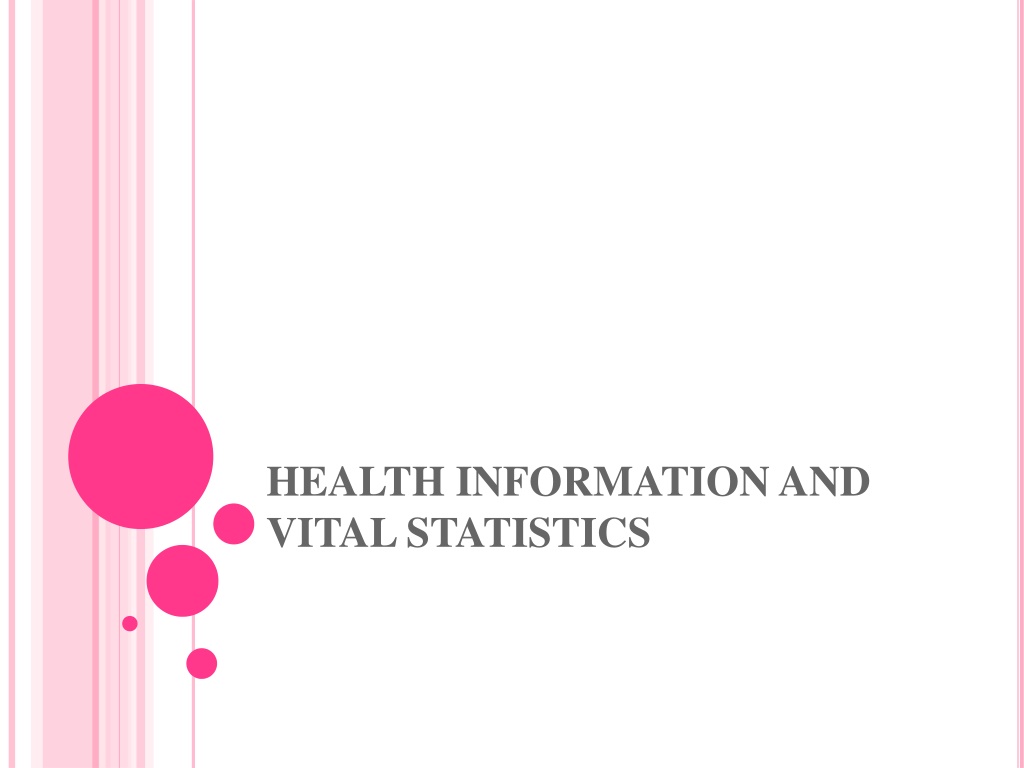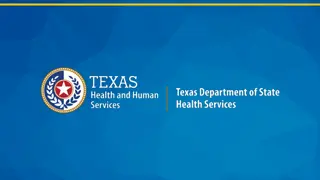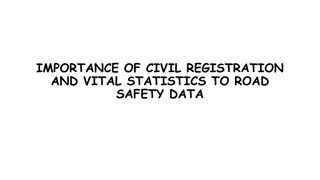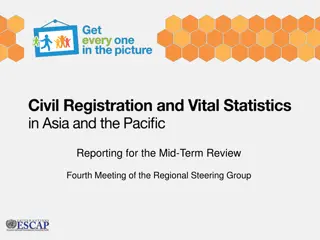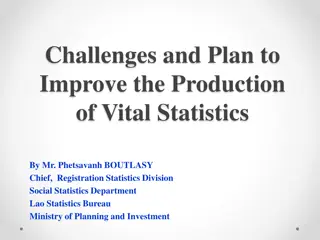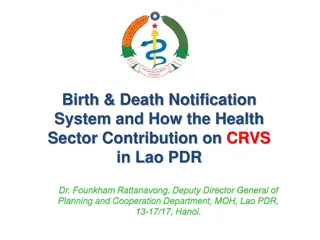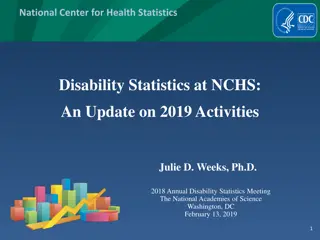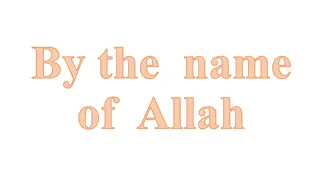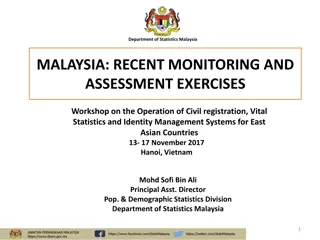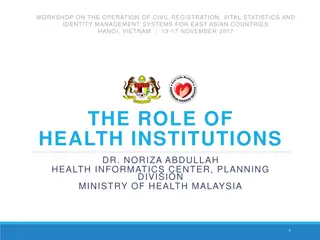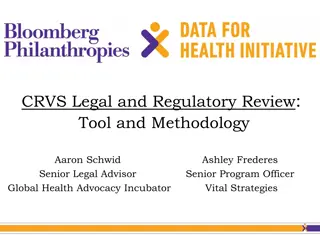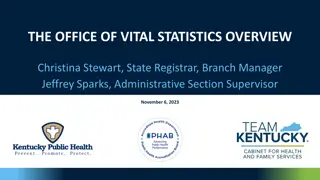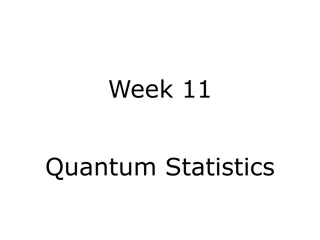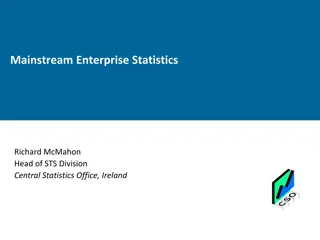Understanding Vital Statistics and Health Information Management
Vital records encompass crucial life events such as births, deaths, and marriages, forming the basis of vital statistics. These statistics serve to quantify and analyze various aspects of health, including mortality, morbidity, and population dynamics. Health Information Systems play a pivotal role in collecting, processing, and disseminating health-related data to improve decision-making and healthcare services. Through a systematic approach, these systems aim to provide accurate and timely information for effective health management.
Download Presentation

Please find below an Image/Link to download the presentation.
The content on the website is provided AS IS for your information and personal use only. It may not be sold, licensed, or shared on other websites without obtaining consent from the author. Download presentation by click this link. If you encounter any issues during the download, it is possible that the publisher has removed the file from their server.
E N D
Presentation Transcript
HEALTH INFORMATION AND VITAL STATISTICS
WHAT ARE VITAL RECORDS? Birth Death Fetal Deaths Abortions Marriage Divorce
VITAL STATISTIC It is define as the facts, systematically collected & compiled in numerical forms related to or derived from records of vital events. These vital events are legally registered.
CLASSIFICATION OF VITAL STATISTICS Mortality Statistic Morbidity Statistic Fertility Statistic Population Statistics 1. 2. 3. 4.
WHAT VITAL STATISTIC MEASURES State of health ( mortality or morbidity) Factors affecting health (housing, social economic & environmental factors) Items of service ( preventive, promotive & curative service) 1. 2. 3.
HEALTH INFORMATION SYSTEM It is a wider concept not only about the health events but management information system is also included in HIS . It has more specific & limited objectives.
DEFINITION OF HEALTH INFORMATION SYSTEM A mechanism of the collection, processing, analysis and transmission of information required for organizing and operating health services, and also for research and training
OBJECTIVES OF HIS To provide Reliable Relevant Up to date Adequate Timely & reasonably complete information for health managers at all levels.
COMPONENTS OF HIS Demography & vital event Environmental health statistics Health recourses Utilized & non utilized health service Financial statistics
PURPOSES/ USES OF HIS To measure the community health For community diagnosis Finding solution for problems Development of procedures, definition, classification & methods of collection, analysis storage & retrieval of date Helps in prioritizing the needs, planning & implementing the intervention Helps in monitoring & evaluation of health program Helps in establishing administrative standards Helps in carrying out IEC activities for community & health worker It demands social support for health activities Used for research & training
RELAVENT TIMELY SENSITIVE QUALITIES OF DATA CAPABLE OF ANALYSIS & INTERPRITATION ACCURATE
SOURSES OF INFORMATION NATIONAL LEVEL LOCAL LEVEL EPIDEMIOLOGICAL SURVEY OTHER SOURSES
POPULATION CENSUS REGISTRAT ION OF VITAL EVENT NATIONAL SAMPLE SURVEY NATIONAL LEVEL SAMPLE REGISTRAT ION SYSTEM NOTIFICATI ON OF DISEASE
POPULATION CENSUS It is the process of collecting , compiling & publishing demographic, economic & social data pertaining at specified time of all person in a country or a delimited territory. First census- 1881. Till 1931 census was carried on the basis of de facto basis- person is calculated where they are present. Afterward on the basis of de jure - permantent residential whether they are present or not.
PROBLEMS DURING DATA COLLECTION Shortage of trained manpower to collect & process information Field work is extremely tedious, dishonest field worker, manipulates figures to give wrong result Many people do not give correct information due to failure on the part of investigator to establish proper rapport with them Costly in term of man, material & money
REGISTRATION OF VITAL EVENTS Registration of birth & death Four types of agencies Panchayat Revenue ( tehsildar, Collector) Police Health 1) 2) 3) 4)
WHO & other internati onal agencies Central DGH State DGH District registrar Rural area
Voluntary registration of vital events started in India after the passage of the Birth , Death & Marriage registration Act 1866 GOI- 1969- Birth in 7 days & Death in 3 day ( urban) Birth in 14 days & Death 7 days ( Rural)
BIRTH CERTIFICATES serve as proof of Citizenship Age Birthplace parentage
BIRTH CERTIFICATE INFORMATION Name Sex Date and time of birth Race of parents Birth order Occupation of father Place of birth Residence of mother Physicians (or attendants) certification
DEATH CERTIFICATES required as burial documents settlement of estates and insurance claims
DEATH CERTIFICATE Name Date and time of death Race Age Place of birth Name and address of survivor (or informant) Place of residence Cause(s) of death Place of death Burial data If death due to injury accident suicide or homicide Physicians (or coroners) certification
SAMPLE REGISTRATION SYSTEM (SRS) Civil registration system is not working properly so SRS was initiated in 1964-65. It is based on dual recording system i.e Continuous registration ( enumeration of vital event by enumerator) Half yearly retrospective survey by the supervisor providing a check on other
FEATURES OF SRS Base line survey by enumerator Continues registration of vital events by enumerator staying in local area. ( enumerator is a part time worker) Half yearly or yearly an independent survey by an investigator ( supervisor is a full time worker) Each supervisor is in charge of 12 enumerators. Matching of events reported by 2 systems. Field verification of matched & unmatched events.
NOTIFICATION OF DISEASE Purposes is prevention and / or control of the disease. List of notifiable disease vary form country to country. Notification system is usually operative through certain legal Acts eg.Madras public health Act1930, epidemic disease Act 1897. International Notifiable disease- cholera, plague, yellow fever. Other disease- relapsing fever, polio, malaria, rabies.
NATIONAL SAMPLE SERVEY 1950-51 continuous activity undertaken by GOI. Collect data r/t social, economic & demographic aspect. The national nutritional monitoring bureau (NNMB)at national institute of nutrition Hyderabad is specially engaged in collecting nutritional data
II. INFORMATION AT LOCAL LEVEL Institutional records Hospital records Information from other survey- environmental health data, information from animal husbandry, educational information.
PRESENTATION OF DATA STATISTICAL DATA CHARTS/ DRAWING TABULATION
TABULATION COMPLE/ MASTER TABLE FREQUANCY DISTRIBUTION TABLE SIMPLE TABLE
CHARTS/ DIAGRAMS BAR DIAGRAM HISTROGRAM FREQUANCY POLYGON LINE DIAGRAM PIE CHART SCATTER/ DOT GRAPH
